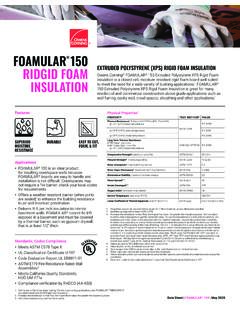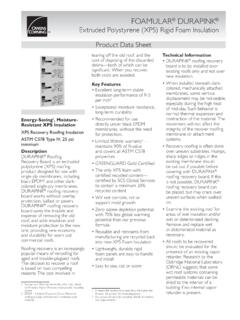Transcription of FIBERGLAS Insulation Product Data Sheet
1 Product data SheetThermal Batt FIBERGLAS InsulationDescriptionThermal Batts are l exible, FIBERGLAS Insulation , made in R-values from 11 to 38. Thermal Batts are available plain, or faced with either a kraft or foil vapor retarder. The Product is manufactured in thicknesses from 3 " to 12".UsesThermal Batt Insulation can be used in a wide range of exterior wall and roof/ceiling applications. The Product can be installed in wood or metal framing cavities, or can be installed between furring and Benei tsExcellent Thermal ControlWith the range of R-values and thicknesses available, Thermal Batts can meet most thermal specii cations with ease.
2 The R30C and R38C provide optimum thermal performance in the limited space of cathedral Acoustical ControlThermal Batt Insulation enhances interior noise control by improving the Sound Transmission Class (STC) of walls and l oor/ceiling Term PerformanceThermal Batt Insulation is dimensionally stable and will not slump within the wall cavity. Due to its inorganic nature, Thermal Batt Insulation will not rot or mildew* and is noncorrosive to steel, copper, and InstallationThermal Batt Insulation is easy to handle and install. Sized for installation in either wood or metal stud construction, Thermal Batt Insulation can either be friction-i t or stapled into place.
3 Trimming and fabrication can be done with an ordinary utility PackagingThermal Batts are compression packaged in exclusive SpaceSaver packaging from Owens Corning. SpaceSaver packaging reduces freight and speeds job site handling/installation. Design ConsiderationsKraft and standard foil facings on this Insulation will burn and must not be left exposed. Install facings in substantial contact with the i nish material. Protect from open l ame or other heat utilizing curtainwall construction may be required to be equipped with a sprinkler system to provide adequate i re protection.
4 Check local building codes for specii c roof/ceiling thermal applications require that the building envelope block the movement of air from the outdoor environment to the conditioned space. Neither the Insulation nor its facing should be relied upon to provide an air barrier. Failure to provide an adequate air barrier could lead to loss of thermal control, discomfort of the building occupants and frozen Burning Characteristics/Building Code Construction Classii cationProductsFlame SpreadSmoke DevelopedICBOBOCASBCCIICCU nfaced<2 5<50A ll Ty pesA ll Ty pesA ll Ty pesA ll Ty pesFoil Faced<75<150 III, IV, VAll TypesAll TypesIII, IV, VKraft FacedN/RN/RIII, IV, VIII, IV, VIII, IV, VIII, IV, VThermal Batt Insulation complies with ICC (International Building Code), ICBO (Uniform Building Code), BOCA (National Building Code)
5 And SBCCI (Standard Building Code) model code requirements for building costruction types listed and standard foil facing will burn. Do not leave exposed. Facing must be installed in substantial contact with an approved ceiling, l oor or wall material. Keep open l ame and other heat sources away from facing. Do not place Insulation within 3 inches of light i xtures or similar electrical devices unless device is labeled for contact with Insulation . Use only unfaced Insulation between wood framing and masonry chimneys. Do not use Insulation in spaces around metal chimneys, i replaces, or l ues.
6 Unfaced Insulation is considered non-combustible by model building codes. Flame Spread 25 products are l ame spread rated and can be left exposed where codes allow. See package for warnings, i re hazard and installation instructions, or call to the potential for skin irritation, unfaced Thermal Batt Insulation should not be used for exposed applications where it will be subject to human contact.*As manufactured, FIBERGLAS Insulation is resistant to mold growth. However, mold growth can occur on building materials, including Insulation , when it becomes contaminated with organic material and when water is present.
7 To avoid mold growth on FIBERGLAS Insulation , remove any water that has accumulated and correct or repair the source of the water as soon as possible. Insulation that has become wet should be inspected for evidence of residual moisture and contamination, and any Insulation that is contaminated should be promptly removed and data SheetThermal Batt FIBERGLAS InsulationWhen Insulation is added to the inside perimeter of a structure, the area outside the Insulation becomes exposed to greater temperature extremes. Building structures should be inspected to ensure they can withstand the additional expansion and contraction forces.
8 Check for piping which should be protected against need for and placement of a vapor retarder in commercial construction depends on many factors. The architect or specii er should evaluate the requirements of each project. If a vapor retarder is specii ed, maintaining the facing integrity may be important for effective moisture/humidity control. Repair any punctures or tears in the facing by taping. Follow the tape manufacturer s application installed too close to light i xtures may affect the luminaire s performance. Do not install Insulation on top of or within 3 of recessed light i xtures unless the i xtures are approved for such use.
9 This is a requirement of the National Electrical to the potential for skin irritation, unfaced Thermal Batt Insulation should not be used for exposed applications where it will be subject to human contact. Installation Between Wood Studs/RaftersThermal Batt Insulation i ts between studs. If required, the l anges can be stapled to either the face or the side of the stud every 8 12" to prevent gaping Product DataAvailable Vapor Retarder FacingsKraftFoilPerms AbsorptionMaximum by VolumeLess than StabilityLinear ShrinkageLess than are tested in accordance:R-Value ASTM C 518 Surface Burning Characteristics ASTM E 84 Perm Rating ASTM E 96R-values differ.
10 Find out why in the seller's fact Sheet on R-values. Higher R-values mean greater insulating Ventilation PassagewayFigure 1 Figure 2 Product data SheetThermal Batt FIBERGLAS Insulationor i shmouthing of the vapor retarder. Unfaced Insulation can be friction-i t between studs after the cover material has been installed on one side of the cavity. Use wire or metal straps to hold Insulation in place in applications without a cover material, or where the Insulation does not i ll the depth of the ceiling products (R3OC and R38C) are intended to be friction-i t between rafters.









